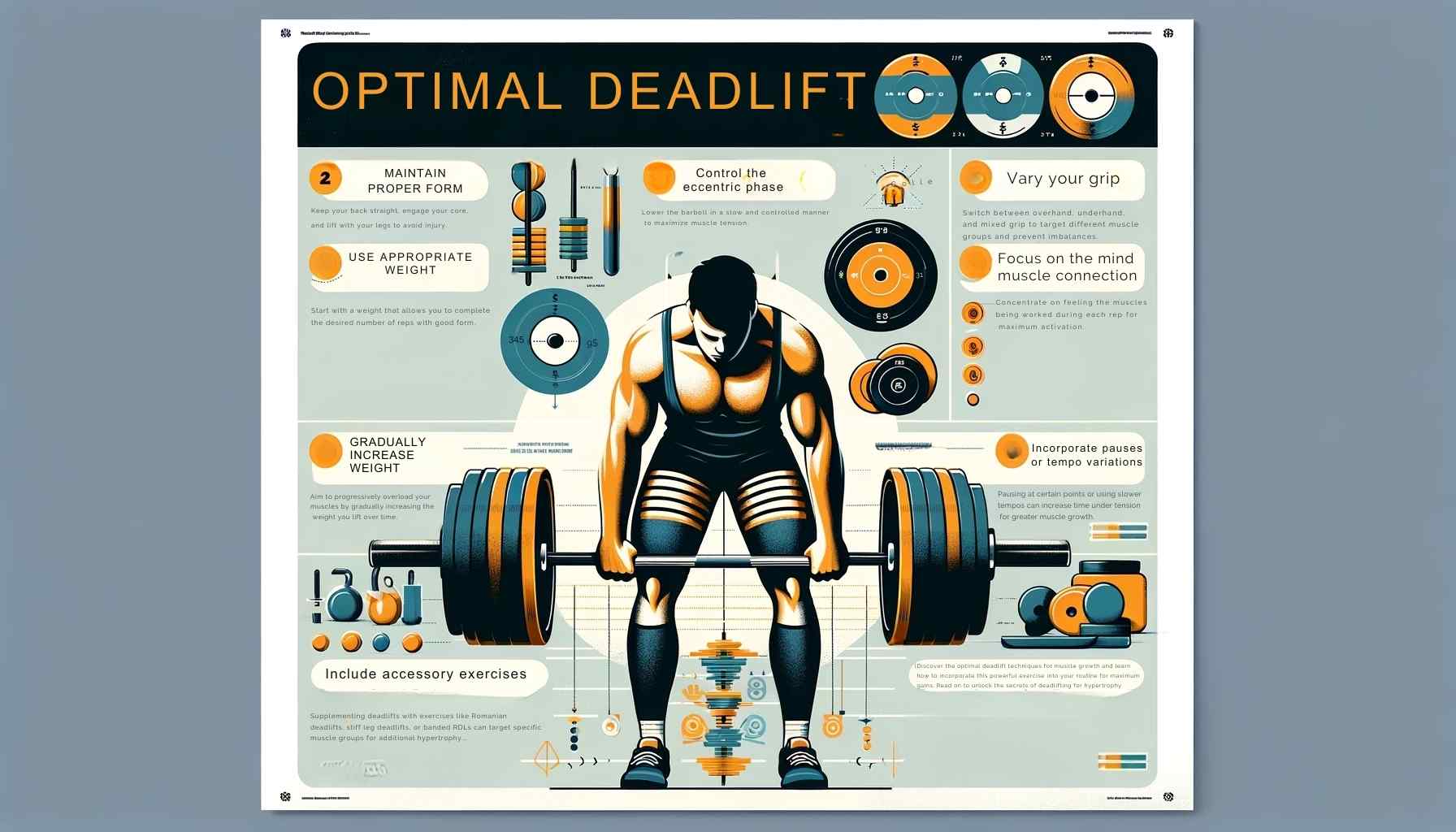Feeling lost on how deadlifts can contribute to your muscle growth efforts? The “King of Lifts,” as commonly known, offers significant potential for boosting hypertrophy. This article provides an in-depth guide on the role of deadlifts in stimulating muscle expansion and how best to utilize them for maximum gains.
Get ready today to supercharge progress in your fitness journey!
Key Takeaways
- Deadlifts are good for hypertrophy because they cause stress on muscles, leading to muscle growth and strength improvement.
- Different types of deadlifts (conventional, sumo, RDL, stiff leg, etc.) target various muscle groups and can be used to focus on specific areas for muscle development.
- High rep deadlifts can promote significant muscle mass growth, improved energy systems, and increased deadlift strength when done correctly.
- Proper form and technique are essential in preventing back injuries while performing deadlifts.
Understanding Hypertrophy and Muscle Growth

Hypertrophy means your muscles get bigger. This happens when you work out a lot and eat the right food. When you lift heavy things, like weights, small tears occur in the muscle fibers.
Your body then repairs these small tears making them stronger and bigger than before. This is how muscles grow.
Proper nutrition plays a key role in muscle growth too. Eating healthy foods with lots of protein helps to fix the muscle faster after a workout resulting in larger muscles over time.
Also gaining enough rest and keeping away stress can help increase muscle size.
What is a Deadlift?
A deadlift is a compound exercise that involves lifting a loaded barbell or dumbbells from the ground to a standing position.
History of Deadlifts
Deadlifts have deep roots. They go back to ancient Greece. The modern barbell deadlift we know now got famous in the early 1900s. Hermann Goerne and Mark Berry were two men who lifted heavy weights with it.
These strong people brought a lot of attention to deadlifts. Now, many cultures and sports use this lift in their activities.
Modern Deadlift Techniques
Deadlifts are a key tool for muscle growth. Here are some top ways today:
- The Conventional Deadlift: Your feet are hip-width apart. Bend at your hips and knees to grab the bar. Keep your back straight.
- The Sumo Deadlift: Your legs are wide in this one. Reach down and grab the bar with your hands inside your legs.
- Romanian Deadlift (RDL): Stand up straight, then lean forward from your hips, not your waist. Your knees stay soft but don’t bend them a lot.
- Stiff Leg Deadlifts: They work like RDLs but with less knee bend.
- Banded RDLs with Dumbbells: This move adds in bands for more pull at the top of the lift.
- Trap-Bar Deadlifts: This uses a special bar you stand inside of to help keep good form.
The Role of Deadlifts in Hypertrophy
Deadlifts aid in muscle growth. This is because they cause a lot of stress on the muscles. When muscles are under such stress, they grow bigger and stronger. This process is called hypertrophy.
Deadlifts target many muscle groups all at once. They can work your leg, hip and back muscles hard when done right.
Using different types of deadlifts can help even more with muscle growth. For example, Romanian deadlifts or stiff leg deadlifts give more focus to some muscles than others do.
This means you can choose which type suits you best for building your body up (hypertrophy). Being safe while doing them is key too. If you don’t lift with good form, you could hurt yourself quite badly.
That’s why it’s important to learn how to do them right before lifting heavy weights.
In summary, deadlifting helps build your body up if done correctly!
Pros and Cons of High Rep Deadlifts
High rep deadlifts can lead to significant muscle mass growth, improved energy systems, and increased deadlift strength. However, they also come with the potential risk of back injury and require good discipline and technique.
To learn more about the benefits and considerations of high rep deadlifts for hypertrophy, continue reading.
Pros: Muscle Mass Growth, Improved Energy Systems, Increased Deadlift Strength
High rep deadlifts offer several benefits for muscle growth. By increasing the number of repetitions, you can stimulate muscle hypertrophy and promote muscle mass growth. The high training volume involved in these sets helps target multiple muscle groups simultaneously, leading to overall development and strength gains.
In addition to muscle mass growth, high rep deadlifts also improve energy systems. These types of deadlifts train anaerobic energy systems that don’t rely on oxygen, allowing your body to become more efficient at producing energy during intense workouts.
Furthermore, high rep deadlifts increase your deadlift strength. By incorporating higher reps into your training routine, you challenge yourself to push through sticking points and break plateaus.
This not only improves your muscular endurance but also enhances overall strength and performance in the exercise.
Cons: Potential Back Injury, Requires Good Discipline and Technique
Deadlifts can be beneficial for muscle growth, but they come with a few drawbacks. One potential downside is the risk of back injury if proper form is not maintained. Deadlifts put a lot of stress on the lower back, so it’s important to use good technique and engage your core muscles to protect your spine.
Additionally, performing high rep deadlifts requires discipline and focus to maintain proper form throughout each repetition. It’s crucial to avoid rounding your back or using poor lifting mechanics, as this can increase the risk of injury.
So make sure you learn proper deadlifting technique and listen to your body to prevent any potential harm while reaping the benefits of this exercise for hypertrophy training.
Deadlifting for Muscle Growth
Discover the optimal deadlift techniques for muscle growth and learn how to incorporate this powerful exercise into your routine for maximum gains. Read on to unlock the secrets of deadlifting for hypertrophy.
Optimal Deadlift Techniques for Muscle Growth
To optimize muscle growth when doing deadlifts, it’s important to focus on the following techniques:
- Maintain proper form: Keep your back straight, engage your core, and lift with your legs to avoid injury.
- Use an appropriate weight: Start with a weight that allows you to complete the desired number of reps with good form.
- Control the eccentric phase: Lower the barbell in a slow and controlled manner to maximize muscle tension.
- Gradually increase weight: Aim to progressively overload your muscles by gradually increasing the weight you lift over time.
- Vary your grip: Switch between overhand, underhand, and mixed grip to target different muscle groups and prevent imbalances.
- Focus on the mind-muscle connection: Concentrate on feeling the muscles being worked during each rep for maximum activation.
- Incorporate pauses or tempo variations: Pausing at certain points or using slower tempos can increase time under tension for greater muscle growth.
- Include accessory exercises: Supplementing deadlifts with exercises like Romanian deadlifts, stiff leg deadlifts, or banded RDLs can target specific muscle groups for additional hypertrophy.
Importance of Back Angle
The back angle during deadlifts is crucial for targeting specific muscle groups and minimizing the risk of injury. When you perform a deadlift with a more upright back angle, such as in conventional deadlifts, you put more emphasis on your lower back muscles.
This can be beneficial if you want to strengthen your back and improve your posture. On the other hand, when you use a more inclined or horizontal back angle, like in Romanian deadlifts or stiff leg deadlifts, you shift the focus to your glutes and hamstrings.
This variation can be great for building strong legs and improving hip mobility. It’s important to find the right balance between these angles based on your goals and body type to maximize results while keeping yourself safe.
The Role of Conventional Deadlifts
Conventional deadlifts play a significant role in muscle growth and hypertrophy. They engage multiple muscle groups, including the hamstrings, glutes, lower back, and traps. By using heavy loads and performing low reps, conventional deadlifts stimulate muscle fibers to promote strength gain and increase overall muscle mass.
Additionally, these deadlifts improve posture and core stability due to the emphasis on maintaining a neutral spine throughout the movement. However, it is crucial to maintain proper form and technique during conventional deadlifts to minimize the risk of injury, particularly in the lower back.
How to Incorporate Deadlifts into Your Workout Routine

To incorporate deadlifts into your workout routine, you need to first identify your goals and then choose a suitable program that includes deadlifts. It’s important to balance deadlifts with other exercises to ensure overall muscle development.
Identifying Your Goals
To make the most out of incorporating deadlifts into your workout routine for muscle growth, it’s important to first identify your goals. Are you looking to build overall muscle mass or target specific areas like your back? Understanding what you want to achieve will help guide your selection of deadlift variations and determine the level of intensity and volume needed in your training program.
Keep in mind that proper nutrition, sleep, and stress management are also key factors in supporting muscle growth when following a deadlift-based program.
Choosing a Suitable Program
To ensure the best results when incorporating deadlifts into your workout routine for hypertrophy, it’s crucial to choose a suitable program. Consider your goals and what you want to achieve with your training.
If you’re focused on building muscle mass and improving your physique, opt for programs that prioritize higher volume and intensity. This means performing more sets and repetitions of deadlifts at challenging weights.
Additionally, balance is important when selecting a program. It’s essential to include other exercises that target different muscle groups to avoid imbalances and promote overall strength development.
Remember that deadlifts alone won’t give you the desired results; they should be part of a well-rounded training plan.
Balancing Deadlifts with Other Exercises
To get the most out of your workout routine, it’s important to balance deadlifts with other exercises. Deadlifts are a great compound exercise that work multiple muscle groups, but focusing too much on them can lead to overtraining and potential injury.
By incorporating other exercises into your routine, you can target different muscles and prevent imbalances. For example, including squats and lunges can help strengthen your leg muscles, while pull-ups and rows can work your upper back effectively.
Remember to listen to your body and give yourself enough rest between workouts for proper recovery.
Frequently Asked Questions about Deadlifts and Hypertrophy
– Can deadlifts help you build muscle??
– Are high rep deadlifts good for hypertrophy??
– What are the benefits of incorporating deadlifts into a workout routine?
– How do you choose the right program to incorporate deadlifts for muscle growth?
– What muscles does the deadlift target for hypertrophy?
– Are there any potential risks or injuries associated with deadlifting?
– Can deadlifting improve your overall strength and performance in other exercises?
– How often should you include deadlifts in your training regimen?
Conclusion
In conclusion, deadlifts can be very beneficial for hypertrophy and muscle growth. They are a powerful exercise that targets multiple muscle groups, including the back, legs, hips, and core.
However, it is important to perform deadlifts with proper form and technique to reduce the risk of injury. By incorporating different deadlift variations into your workout routine and progressively increasing the weight over time, you can maximize muscle growth while minimizing potential risks.
So go ahead and give those deadlifts a try!
FAQs
1. Are deadlifts good for hypertrophy?
Yes, deadlifts are great for bulking up muscles and improving strength. They carry benefits like muscle tension and endurance, playing a key role in progress overload.
2. Can I do sumo deadlifts to enhance back hypertrophy?
Yes, sumo deadlifts can boost the growth of hip muscles and your back as well. It’s a strongman training mode that helps you flex muscles better.
3. How does exercise form impact my strength training during deficit deadlift?
Exercise form is very important in deficit deadlifiting. A wrong posture can lead to back rounding which isn’t healthy at all.
4. What kind of athletes should perform dips or front squat exercises?
These exercises are best suited for bodybuilders, power lifters and weight lifters who aim to work on full-body lifts and improve their technique.
5.What other exercises could help me grow my muscles apart from conventional moment pattern workouts like barbell curl or dumbbell rows?
Other helpful routines include overhead press, cable flyes, lateral raises,and preacher curls which focus on different muscle groups improving fitness alongside increasing metabolism rate aiding fat loss.
6.Will it be safe for novice athletes to try high-intensity load workouts right away?
It might not be advisable due to risk of pre-existing injuries or major weaknesses.It is recommended they start with lower intensity regimens before moving onto high-intensity loads.


